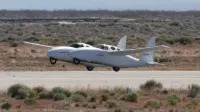Burt Rutan designs hybrid flying car

It’s a bi-pod airplane with a 31-foot wingspan when you want it to be, and a seven-foot-wide, deliciously odd grocery getter when you don’t. There’s a lot that’s novel about the design, including its Chevrolet Volt-like gasoline generator powering electric motors that makes up its propulsion system.
Rutan also addressed the problem of unifying car and airplane controls by putting each set of controls in a separate pod. On the right, you have a yoke for when you’re airborne. On the left, the controls for travel on terra firma.
The Model 367 cruises at 100 miles per hour, and has an estimated range of 760 miles. Push it, and you can hit 200, but that knocks your range down to just 530 miles. For what it’s worth, Rutan says this will be his last project before his previously announced retirement goes into effect. See the complete press release after the break.
[Source: via Wired]
Scaled Composites has developed a hybrid gasoline‐electric roadable aircraft as part of an internal research and development program with the intent of strengthening its electric propulsion capabilities. The aircraft, Scaled Composites Model 367 or “BIPOD,” was the final design of Scaled’s founder and former CTO, Burt Rutan, prior to his retirement in April 2011. Rutan had been toying with the idea of personal electric aircraft, including VTOL and roadable concepts, for at least a decade.
The BIPOD program was conceived as a rapid, low‐cost electric test‐bed using as many COTS components as possible. During initial conceptual design studies, Scaled found that many of their propulsion system characteristics were well aligned with the drivetrain needs of a roadable vehicle and expanded the research program to include a “flying car” airframe.
With the impending deadline of Rutan’s retirement, Scaled Composites pursued an aggressive schedule and successfully achieved first flight of the BIPOD vehicle within four months of beginning preliminary design. The entirely new design will operate as a high‐performance airplane with STOL capabilities, 200 mph maximum speed, and 700 mile range or as a road commuter vehicle capable of freeway speeds, urban driving, and garage storage.
Rutan and his team took a novel approach to solving many of design challenges associated with a roadable aircraft. Scaled placed a large emphasis on developing a configuration that was safe for ground operations, yet still efficient at high flight speeds.
Accordingly, BIPOD’s twin fuselage configuration provides a low‐drag enclosure for a robust, 4‐wheeled chassis with two cockpits, while providing a protected storage location for the wings and tail surfaces during ground operations.
Two internal combustion engines, one per fuselage, provide power to the rear wheels and to propellers located on the horizontal stabilizer. Lithium batteries in the nose provide additional energy for take‐off and in the case of an engine emergency. The vehicle’s center of gravity is positioned for ground operation stability, while aircraft rotation is enabled by direct blowing of the horizontal stabilizer and by applying power to the rear wheels.
The use of electric power transmission decouples engine location from propeller location without the need for mechanical shafts and gearboxes, enabling BIPOD’s unique geometry.
The vehicle performed well during initial ground and flight testing. The low center of gravity and wide track resulted in a stable, controllable road configuration both on the skid pad and at freeway speeds. Initial flight tests indicate that the vehicle is stable and controllable.
Scaled is continuing to test and develop the BIPOD configuration and hybrid propulsion system, with the goal of using similar systems on future unique aircraft configurations. Despite the inherent inefficiencies associated with energy conversion steps, Scaled Composites believes hybrid systems may offer advantages for specific mission requirements, such as distributed propulsion, multi‐mode operation, or energy recovery.
Furthermore, the use of carbon fuels provides better energy density and a lower gross take‐off weight for the same range when compared to electric‐only vehicles.
Ultimately, the BIPOD configuration will provide a unique propulsion system test bed in an operational flight vehicle, providing Scaled Composites experience with a number of different powerplants and associated systems.




